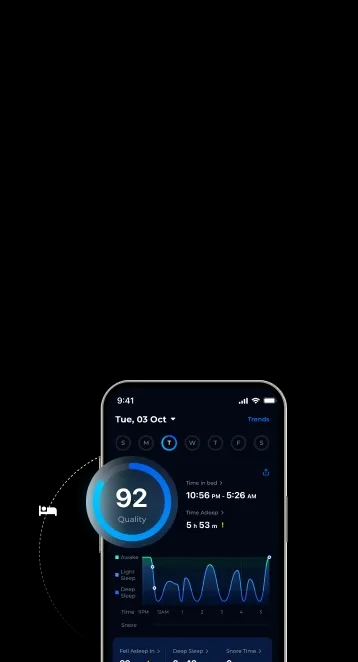


Do you classify yourself as an ‘early bird’ or a ‘night owl’? While these terms are often casually thrown around to describe sleep habits, it is actually scientifically proven to be real terms. These labels are known as chronotypes— natural sleep patterns that are tied to our circadian rhythm.
In this article, we will explore and dig deeper into what chronotype is, the 4 popularized types of chronotype, and how it connects to sleep quality. If you’re ready, keep reading below to find out more.
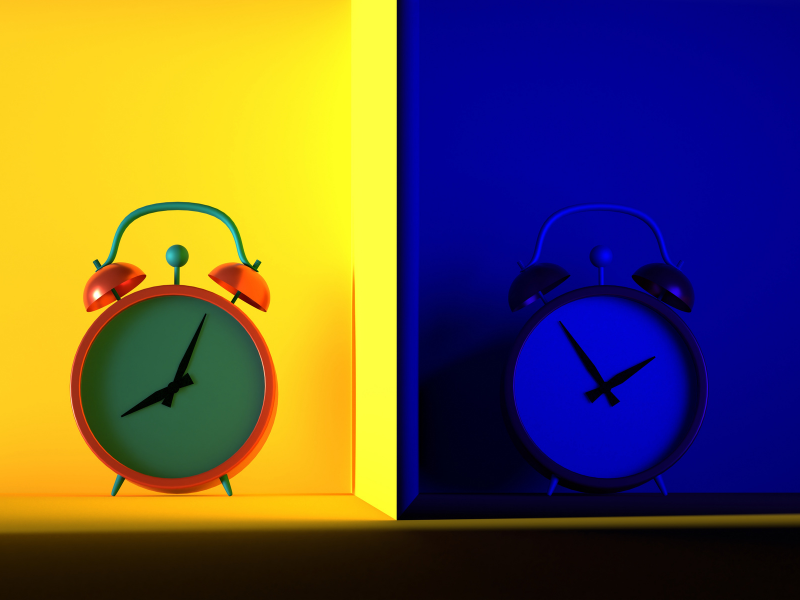
Chronotype is a part of our internal body clock, known as circadian rhythm. It is usually defined as a person’s natural preference to sleep and wake at a certain time [1]. It can be influenced by internal factors like genetics or external factors such as light exposure.
Chronotypes can affect aspects of our daily lives, including body temperature, appetite, productivity, eating, and sleep patterns [2].
According to various recent studies, chronotypes can be divided into 3 types— morning, evening, and intermediate chronotypes [3].
Individuals with morning chronotype, also known as early chronotype or larks, prefer to be active early in the morning, go to sleep early, and wake up early.
Evening chronotypes, also known as late chronotypes or night owls, prefer to be up in the evening, go to bed, and sleep late.
The intermediate chronotype is seen as neutral. If you fall within this category, you are neither a morning person nor a night owl. Rather, you can switch between both.
Studies also show that those with morning and evening types perform differently. People with morning chronotype had the best physical and mental performance early in the day while those with evening chronotype had the best performance before sleep [1].

In the earlier section, we mentioned that there are 3 types of chronotypes. So, why are there suddenly 4 types?
Well, this is a result of differences in research and interpretation. The 4 sleep chronotypes are famously established by clinical psychologist and sleep doctor, Michael J. Breus Ph.D.
According to Dr Breus, the Morning-Eveningness Questionnaire (MEQ) does not take sleep drive, personality factors, and behavioral traits into account when determining chronotype. He believed that all of these are the main components of chronotype.
To solve this, Dr. Breus introduced a new system that expands the traditional three chronotypes into four distinct types, which he named after animals to better represent the different sleep patterns and behaviors [4].
Below, you will find the 4 different types and each of their characteristics.
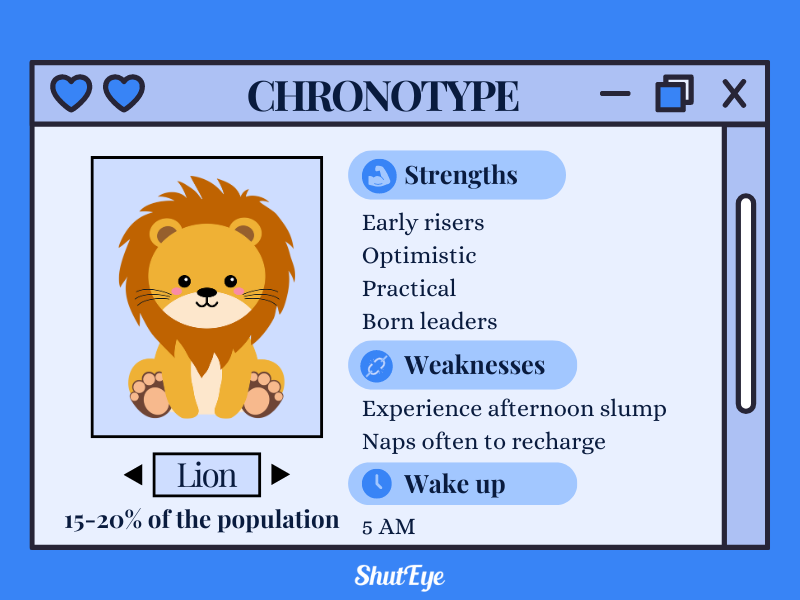
Lions are known to be early risers, typically the most active and productive at dawn. People with the lion chronotype tend to equally be early risers, often waking up around 5 a.m.
You can expect that someone of this type will remain the most energetic and productive, breezing through tasks efficiently right until it reaches midday. At this point, this group will experience an afternoon slump, often needing to take naps to recharge and get themselves ready to take on the day once again.
Also, some other key features worth noting are that lions tend to be optimistic, practical, and natural leaders and they also tend to be good sleepers with a medium sleep drive.
Lion chronotypes have a lower risk for cardiovascular disease, obesity, depression, and anxiety.
Approximately 15 to 20% of the general adult population have this chronotype.
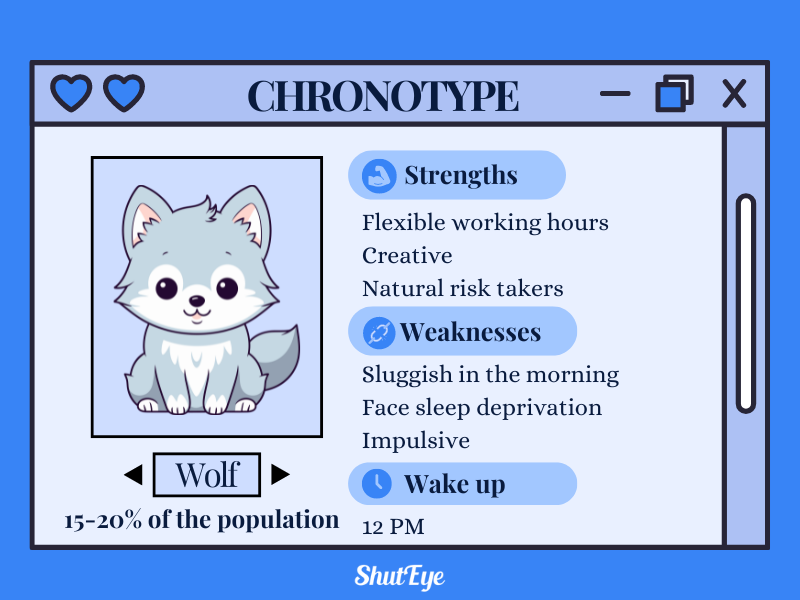
Wolves are naturally nocturnal animals, thriving the most during nighttime. Just like their animal counterparts, people with the wolf chronotype tend to wake up much later in the day and are more energetic and productive during then.
It may be difficult for those with wolf chronotype to adjust to a standard 9-to-5 schedule as they tend to be more sluggish and unproductive in the morning. They tend to work better in environments with flexible working hours.
People with wolf chronotype also tend to be creative thinkers, impulsive, and emotionally intense. As natural risk-takers, they love to seek out new experiences. However, they may be highly susceptible to social jet lag and insufficient sleep which puts them at risk for chronic diseases such as cardiovascular disease.
Overall, wolf chronotypes perform best with 7 hours of sleep because of their biological rhythms. About 15 to 20% of the population have this chronotype.
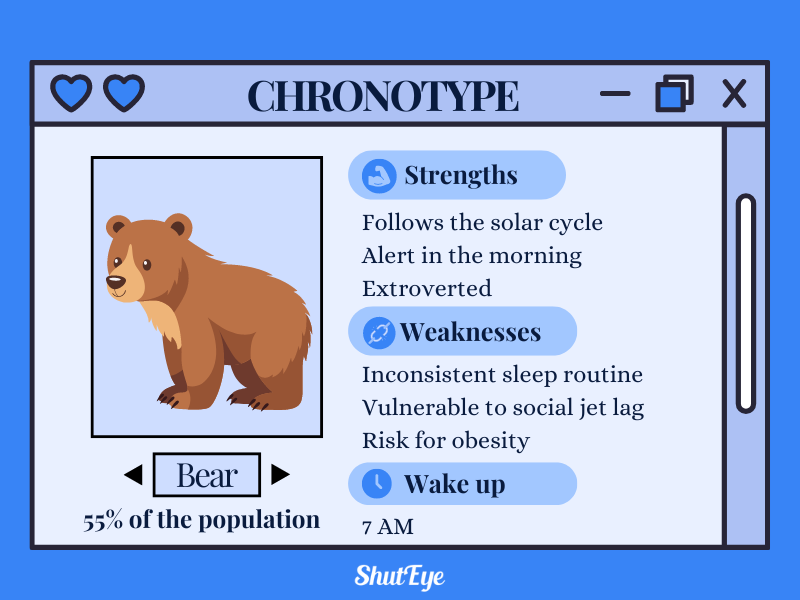
Bears are animals that follow the solar cycle, waking up when the sun rises and winding down for rest as soon as the sun sets. This chronotype is the most common human chronotype, found in nearly 55% of the population.
Those with bear chronotypes usually feel the most alert and productive during the mid-morning to early afternoon. They also have a high sleep drive, typically needing 7 to 8 hours of deep sleep. However, many bears may have an inconsistent sleep routine, which leads to sleep debt.
Additionally, they are highly vulnerable to social jet lag which can increase their risk for obesity.
Overall, bears are best suited for a lifestyle that is well-balanced with a steady routine where they can wind down in the early evening.
You may also like: Sleep Duration: How Much Sleep Do You Need?
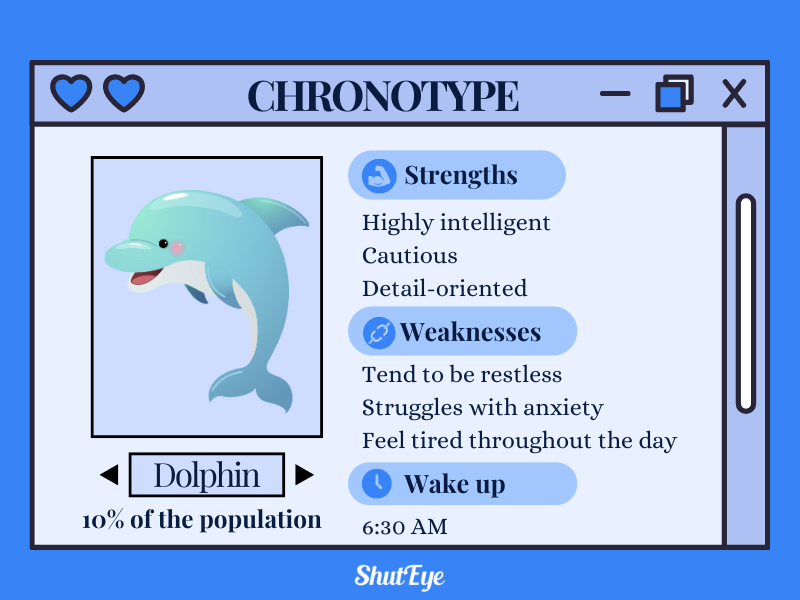
In the world of mammals, dolphins are known to sleep with half of their brain on at a time— to stay alert of predators. It is the same reason why they tend to be restless, light sleepers.
With them being restless and nervous at night, it is no wonder why dolphins are never able to fully fall asleep, and often wake up frequently throughout the night. People with this chronotype tend to struggle with an overactive mind and racing thoughts, causing insomnia and frequent waking during the night.
Those with a dolphin chronotype are often most productive in the late morning but may feel tired throughout the day due to the fragmented sleep patterns.
Overall, you may find that people of the dolphin chronotype are highly intelligent, cautious about their surroundings, and detail-oriented. They may also experience trouble sticking to a consistent sleep routine due to anxiety and restlessness.
This is considered the rarest chronotype, with only about 10% of the population falling into this category.
Your chronotype plays a huge role in shaping your daily life as a whole. It can affect your daily habits, appetite, exercise, and body temperature. Not only that, it also affects your productivity level, mood, and how well you perform tasks throughout the day.
For instance, if you have a morning chronotype, you would likely feel most alert and productive in the morning. If you have an evening chronotype, you will feel more productive in the late afternoon or evening.
Chronotype can also influence your sleep quality and how well you align with typical schedules so if you have a mismatched chronotype, you may struggle with sleep debt, fatigue, or have some difficulties adjusting to societal routines.
After seeing all 4 chronotypes and their characteristics, you might feel a bit confused. You might identify with some characteristics of one chronotype and follow a sleep schedule like another.
Figuring out the chronotype that best represents you may seem tricky but it is actually a rather simple and straightforward process.
The most common way to identify your chronotype is by taking a quiz, such as the Morningness-Eveningness Questionnaire (MEQ) or the Munich Chronotype Questionnaire (MCTQ) [5]. These quizzes evaluate your sleep patterns, energy levels, and daily preferences to determine if you are an early riser or night owl.
Other ways to determine your type can also be to track your sleep habits. Monitor your sleep-wake patterns and consider whether you feel better getting up early or slightly later in the day. Also, consider your productivity levels during different points of the day.
Understanding your chronotype is a good way to start making better lifestyle changes and improving your sleep quality.
Deliberately changing or retraining your chronotype is not possible. However, you can change your habits instead to align with your lifestyle. This is because chronotype is largely influenced by genetic factors so if you are naturally an early riser, you will always tend to be this way.
At the same time, it can be influenced by environmental factors that change over time. This means that if you want to wake up slightly later, you can take steps to gradually shift your sleep schedule. Managing light exposure and making lifestyle adjustments are ways to adjust your circadian rhythms.
Your chronotype also naturally shifts as you grow up (e.g. childhood, teenage years, adulthood) [6].

Once you are able to pinpoint the exact chronotype you are, it becomes a powerful tool in helping you increase productivity. It is about working with your natural rhythm rather than against it.
One of the ways to increase productivity is to tailor your daily activities based on when your energy and productivity levels start to peak.
For morning larks, this means getting up and getting your work or daily activities done early in the morning. For intermediate chronotype, this means doing it closer to mid-morning or early afternoon while for night owls, it will be afternoon or late afternoon.
Additionally, if you have a lot of tasks to do on any given day, you should plan your schedule according to the hours that you find yourself to be most productive. Create time blocks if necessary.
In conclusion, knowing your chronotype is not just about helping you to maximize your productivity but it also correlates with sleep. It helps you to determine when you would feel more sleepy, whether you are a light or deep sleeper, and from there, you can alter your sleep schedule to help you sleep better, prevent sleep disorders, and improve overall well-being.
Working with your chronotype, not against it, helps you to take control of your sleep and daily life. Discover how you can gain back control of your sleep with the ShutEye® app, a patented sleep-tracking app that provides you with personalized sleep recommendations.
Breus, M. J. (2021) The Four Chronotypes: Which One Are You? [online]. Available at: https://www.psychologytoday.com/sg/blog/sleep-newzzz/202104/the-four-chronotypes-which-one-are-you
Chauhan, S., Norbury, R., Faßbender, K. C., Ettinger, U., & Kumari, V. (2023). Beyond sleep: A multidimensional model of chronotype. Neuroscience & Biobehavioral Reviews, 148, 105114. Available at: https://doi.org/10.1016/j.neubiorev.2023.105114
Lee, J. H., Kim, I. S., Kim, S. J., Wang, W., & Duffy, J. F. (2011). Change in Individual Chronotype Over a Lifetime: A Retrospective Study. Sleep Medicine Research, 2(2), 48–53. Available at: https://doi.org/10.17241/smr.2011.2.2.48
Roenneberg, T., Wirz-Justice, A., & Merrow, M. (2003). Life between clocks: daily temporal patterns of human chronotypes. Journal of biological rhythms, 18(1), 80–90. Available at: https://doi.org/10.1177/0748730402239679
Zou, H., Zhou, H., Yan, R., Yao, Z., & Lu, Q. (2022). Chronotype, circadian rhythm, and psychiatric disorders: Recent evidence and potential mechanisms. Frontiers in neuroscience, 16, 811771. Available at: https://doi.org/10.3389/fnins.2022.811771